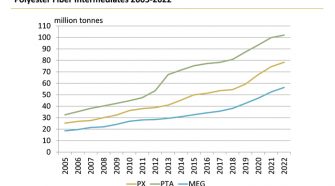
Despite a declining share, staple fibers remain a big piece of the global fiber market
Staple fibers hold a large share of the global fiber market, with last year’s output comprising about 57 million tonnes in a total market size of almost 106 million tonnes. …

Global development of spun and filament yarns
Filament growth rates have been faster for most of the almost four decades shown in the next chart than the world fiber market movement. Their long-term growth rate amounts to …

Rising investments in manmade fiber feedstocks
Synthetic fibers account for more than 60 percent of the world fiber market, and their ongoing growth is supported by comparatively low crude oil prices in recent years despite increasing …

Market trends in fiber import-export countries worldwide
Most of the top-10 exporting countries lifted their shipments in value terms in 2018 (Figure 1). The recovery of Chinese exports continued with the total value increasing 4 percent to US $277 billion. However, value-added garment exports remain about 15 percent below their peak 2014 level, without any significant movement over the past three years. Knitwear and woven apparel exports remain among the top-10 Chinese export categories, albeit gradually losing weight as the Chinese economy continues to diversify.

Fiber industry faces economic headwinds
The world economy started off on an optimistic note in 2018, following growth in manufacturing and trade the previous year. But optimism gave way to a downturn from midyear, as the International Monetary Fund revised down its 2018 projections for most advanced economies and predicted significantly lower growth expectations for 2019.

